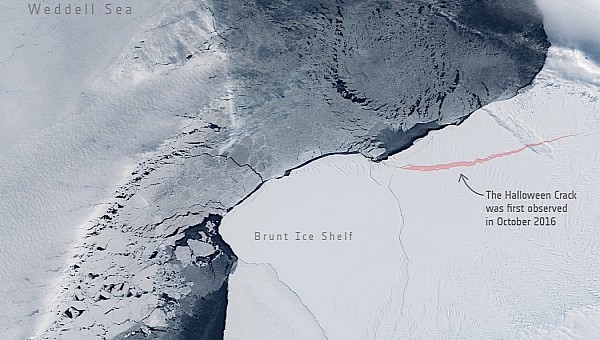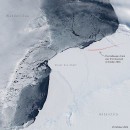Our planet is in pretty bad shape and to no fault of its own. Human activity over the past few centuries has brought Earth to the brink of many nasty things waiting to spill over. Among them, and of great concern, the breakout of ice at the poles.
Back in May of last year, for instance, the Copernicus Sentinel mission (two satellites floating in space with the mission to scan the poles for changes) discovered the world’s largest iceberg. Called A-76, it has a total area of 4,320 square km (2,684 square miles), larger than the Spanish island of Majorca, and broke off the Ronne Ice Shelf (allegedly not because of global warming, but because of calving).
But that’s just one of many icebergs, be them planning or fully-committed to floating on the world’s water. Because it’s Halloween, the European Space Agency (ESA) thought to remind us of a potential one near something called... the Halloween Crack.
First spotted by Sentinel on Halloween day in 2016, the Halloween Crack runs right up next to the Brunt Ice Shelf, it too barely holding on to the greater Antarctica. The Crack itself is now stable, according to ESA, but its proximity to Brunt makes people nervous. If and when the shelf breaks off, it could become an iceberg of 1,750 square km (676 square miles) in size, which is about five times the Mediterranean island of Malta.
That may be a lot smaller than A-76, and given how that one didn’t increase the levels of our seas and oceans significantly, people might be inclined to believe things are not as bad as they sound, after all.
But ESA warns a key aspect of ice shelves, which is to act as brakes on glaciers and prevent them from moving out to sea, is impacted in Antarctica, and that may lead to “greater risks of more land ice ending up in the oceans and thereby adding to sea-level rise, something arguably more frightening than Halloween.”
But that’s just one of many icebergs, be them planning or fully-committed to floating on the world’s water. Because it’s Halloween, the European Space Agency (ESA) thought to remind us of a potential one near something called... the Halloween Crack.
First spotted by Sentinel on Halloween day in 2016, the Halloween Crack runs right up next to the Brunt Ice Shelf, it too barely holding on to the greater Antarctica. The Crack itself is now stable, according to ESA, but its proximity to Brunt makes people nervous. If and when the shelf breaks off, it could become an iceberg of 1,750 square km (676 square miles) in size, which is about five times the Mediterranean island of Malta.
That may be a lot smaller than A-76, and given how that one didn’t increase the levels of our seas and oceans significantly, people might be inclined to believe things are not as bad as they sound, after all.
But ESA warns a key aspect of ice shelves, which is to act as brakes on glaciers and prevent them from moving out to sea, is impacted in Antarctica, and that may lead to “greater risks of more land ice ending up in the oceans and thereby adding to sea-level rise, something arguably more frightening than Halloween.”






